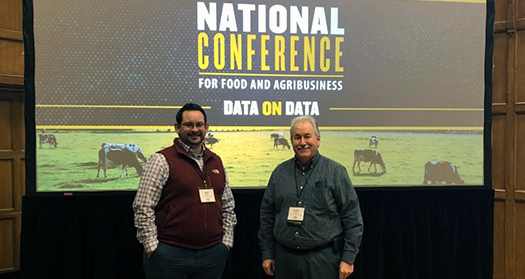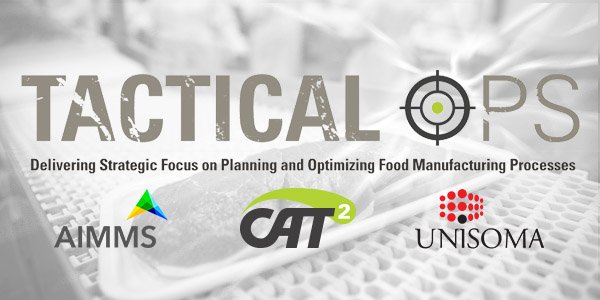At Purdue University's National Conference for Food and Agribusiness, speakers presented results of the University’s research study analyzing what data is collected across the food value chain, how it’s shared, and to what extent it is used to make strategic decisions. The study focused on five levels of the value chain: (1) Ag Input Manufacturers, (2) Ag Retailers, (3) Farmers, (4) First Handlers/Food Processors, (5) Food Manufacturers, and (6) Food Retailers. The event included panel discussions with representatives from each part of the value chain discussing trends they’re experiencing.
How is Data Analytics Transforming Ag?
“On the macro level, data analytics are pushing for a more integrated view on farmers and farming,” said Luciano Castro, associate director for strategic initiatives at Purdue University. “This has reshaped, or forced a reshaping, in the industry’s structure because it is challenging industry-segment boundaries on the traditionally siloed view of inputs: fertilizers, seed, chemicals, and machinery. On a micro level, the ability to collect, interpret and capitalize on the data being generated requires a very different set of capabilities.”
This demand for new skills and capabilities is driving a change in the workforce. “Consumer views are what you see in the news, but what you don’t hear about is what’s going on with the producer,” said Rob Dongoski, partner and global business leader at Ernst & Young. “Farms are becoming bigger, more corporatized. The sophistication of farms is driving change. Farmers are asking new questions, forcing a change in the salesforce for agricultural products. Workers must think more in MBA terms rather than just in terms of product functionality. They need to be capable of answering questions like ‘if we use CRISPR, AI, or other technologies, by how much can we reduce time to bring seed to market?’ Additionally, sales are less about product features and functionality, and more about customer experience. ‘What is your service like? If your product breaks down, how do I get it serviced? How do I innovate during a recession and not just bunker down and survive?’ Customers care about the ease of engagement and expertise of their suppliers.”
The Purdue University study revealed a dramatic shift in how data is used at the farm level. In a 1997 study, of the farmers surveyed, 30 percent were doing soil sampling, 3.6 percent of those were sampling with GPS. The most common reasons for not collecting data at that time were that farmers considered it cost-prohibitive, and many didn’t see value in the data. Additionally, no questions were included on data privacy and data sharing across the value chain in the 1997 study.
For the 2019 study, researchers surveyed 800 corn and soybean producers. Questions focused on their data collection practices, management and usage of farm data. The team targeted farms with 1,000 acres or more, creating a sample of farms most likely to have active data strategies. A sampling of survey results is included below:
“Eighty-two percent report using a yield monitor, 77% perform soil testing and 47% collect drone or satellite imagery. Use of data software is also high at 44% of all respondents. Among data software users, the most popular are Climate FieldView (52% of subscribers), John Deere Operations Center (44%), Case-IH AFS Software (22%) and Trimble (21%). Large corn and soybean growers are not averse to sharing their data with service providers—74% share their data with an agronomist, input supplier, custom service provider, equipment dealer or other outside parties for the purpose of generating crop management recommendations.
“Thirty percent of those collecting data report that their data has a large influence on their seeding rate decisions. For nutrient management and drainage decisions, the proportion is 54% and 30%, respectively. Decision-makers were followed up with a question about the effect of their data-driven decisions on yield outcomes. Over 70% of those using data to make decisions report a positive yield impact, indicating a high degree of satisfaction with their data strategies.” (SOURCE: https://agribusiness.purdue.edu/understanding-farm-data-usage/)
How are Consumer Perceptions Affecting Food Labeling?
According to the survey data, many changes are being driven by about 30 percent of consumers. Of the consumers surveyed, 70 percent said there was no additional information they wanted to see on a food label. Of the 30 percent who desire more information, many want to know the location where their food was produced.
The survey also revealed consumers hold widespread misconceptions about the food supply chain. For example, when asked whether broilers are given growth hormones. Only 8-percent of survey participants answered it correctly. (No broilers are given growth hormones.) This illustrates a great opportunity for the food industry to better educate the public. However, this will prove challenging in the current social/political climate. Trust in manufacturers has changed. Science is no longer trusted.
“People who think GMOs are good usually think science around climate change is bad, people who think science around GMOs is bad usually think science around climate change is good,” said Dongoski “When are we talking about science, and when are we talking about marketing? I actually saw a label advertising non-GMO water! Right or wrong, the final arbiter of science is the consumer because they decide what they will spend money on.”
“Sometimes the winners are those on Twitter who never looked at the science but have the loudest voices,” said Michael Shackelford, advisory services lead from Ernst & Young. “Manufacturers are having to respond to claims that they are sourcing products from a non-sustainable resource, and they’re having to combat these claims with reliable data. How are you treating your employees? How are you sourcing your products?”
What Consumer Trends are Impacting Food Production and How?
The presentations and panel discussions explored many forces impacting all sectors of the food value chain from population growth and urbanization to diet trends and consumer concerns about proper animal care practices.
“The population is growing, which means more food is needed, and it will need to be produced on less space,” said Dongoski. “Our industry needs to seek out strategies to build responsibly.”
“In reality, the value chain is not a chain, but a web,” said Colleen Webster, advisory risk transformation team lead for Ernst & Young. “Consumers want apricots in November, and we have to provide that for them. When a recall happens, it just doesn’t affect a small community. It affects everyone in a major way. There’s a rising middle class in China. We’re having to safely provide products to areas of the world we didn’t think about in the past. The industry is being pushed for increasingly nimble product innovations. How do we get products produced and delivered safely?”
“The content of food is changing dramatically,” said Dongoski. “Consumers are craving different foods, and they have the perception that smaller is better, leading to more regional foods. Some producers don’t want to get too big because consumers think big food is bad. This is going to impact land use.
“Consumer preferences are continuing to drive changes for retailers. With the popularity of diet trends like paleo, more consumers are gravitating toward the perimeter of the store and avoiding the center of the store where the processed foods are located. The perimeter is where we’re seeing verticalization, and, in fact, the perimeter may begin to encroach on the center of the store.
“Urbanization rates are accelerating, but trends show people want to have a closer relationship with the producer. I can foresee a future where we’re growing live food in the grocery store, where customers can cut a head of fresh lettuce themselves.
“In the meantime, how do we satisfy the consumers' desire to get closer to the producer? You do it with data. What consumers really want to know is how did you treat that pork loin? What did you feed it? What are your values?”
“Consumers are wanting more data,” said Renee Greenwalt, advisory risk transformation team lead from Ernst & Young. “Seeing news about recalls and outbreaks erodes consumer trust, food producers and retailers need to provide transparent data to maintain trust.”
How are Food Value Chain Participants Responding to Industry Changes?
The panel discussed various shifts occurring along the supply chain including product innovation, business-model changes, and process standardization.
“Retailers are going around manufacturers if they can’t get the relationship they want,” said Shackelford. “Costco is developing its own poultry facility [for example]. Costco is very selective over who it allows in its store. Your track and trace capabilities add to the trust in their brand. Traceability makes your brand more attractive to more retail customers. Retailers want to satisfy consumers. Manufacturers who best understand and respond to what consumers want will win.”
Product innovation is putting new demands on processors. “We’re under increasing pressure to reduce the standard deviation in grain and flour for our bakery customers,” said Kevin Pray, vice president of Miller Milling.
“There are new opportunities to differentiate between bulk commodities and premium products that can be created through value-added data,” said Dr. Mindy Mallory, Purdue University associate professor and Clearing Corporation Charitable Foundation endowed chair of food & agricultural marketing. “First handlers have the biggest opportunity to benefit from data sharing and also the greatest challenges.”
“Market changes are also driving business-model innovation,” said Dr. Mallory. “Outcome-based and risk-based models are driving innovation. There are examples in the beef industry of using predictive modeling to determine whether a cow might survive with certain food and genetic testing. Another example is Monsanto’s initiative where they are sharing some risk with their customers.”
Customer demands, increased competition, and changing technology are driving changes in how data is stored and used. “It used to be that all of your data was housed and processed onsite,” said Shackleford. “Now you can migrate to the cloud and leverage capabilities from other industries like data analysis and financial services. It doesn’t all have to be hardcoded onsite. Also, data sharing is important, and partnering is just as important. If one supplier is shipping product at 38 degrees, but the manufacturer needs it at 48 degrees, the manufacturer has to let it sit for a day to get up to 48 degrees. Stronger partnering and better communication can dramatically increase efficiency across the supply chain.”
“The average recall costs $10 million,” said Webster. “Track-and-trace is critical. We need to get faster and smaller when things go wrong. The global supply chain has increased in complexity. A company could have 3,000 ingredients from multiple suppliers. We need better tools for knowledge sharing. Not enough time being used to communicate best practices. As much as the industry dislikes regulation, regulations can be good by creating standardization. Standardization is necessary to harmonize data across the globe, which is necessary for digital technologies to be interoperable.”





